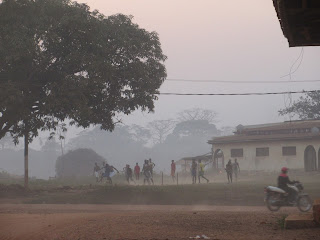Before our visit in December 2015, we knew that the East Region of Cameroon had a sparse population that was fairly isolated due to a
number of unpaved main roads. We also expected that it would be
poorer as a result of its distance from the capital and coast, as
well as the limited infrastructure. The primary users of the main
roads seemed to be logging trucks, which in turn drove a lot of
commercial activity.
 |
| Dusk soccer match in Yokadouma. |
Southeastern Cameroon also had a
surprisingly large Muslim population. We frequently saw Fulani
herdsmen with their cattle as we travelled, and indeed the
transportation from Bertoua to points north and south was generally run
by Muslims (mostly Fulas from the north). Given that the Sahel region
is generally where demographics of African countries shift from
predominantly Christian to more Muslim (although the West Region of
Cameroon is an exception to this norm), this was definitely a
surprise. Of course, CAR has a significant Muslim minority which may
have contributed to northerners making their way down here.
 |
| Main roundabout in Batouri. |
The climate was also quite cool, especially in comparison to Douala. We could have done with sweaters in the evenings and mornings in Lobeke National Park, even though the park is in the Congo river basin, which conjures (up) expectations of steamy rainforests.
 |
| Distances from Batouri to Cameroonian towns and Bangui, CAR. |
Finally, the generator at Hotel
Elephant in Yokadouma ran all the way until 5AM!















![Expat [DESTINATIONCOMPLETE]](http://www.expat.com/logo/expatBlogSmall.gif)